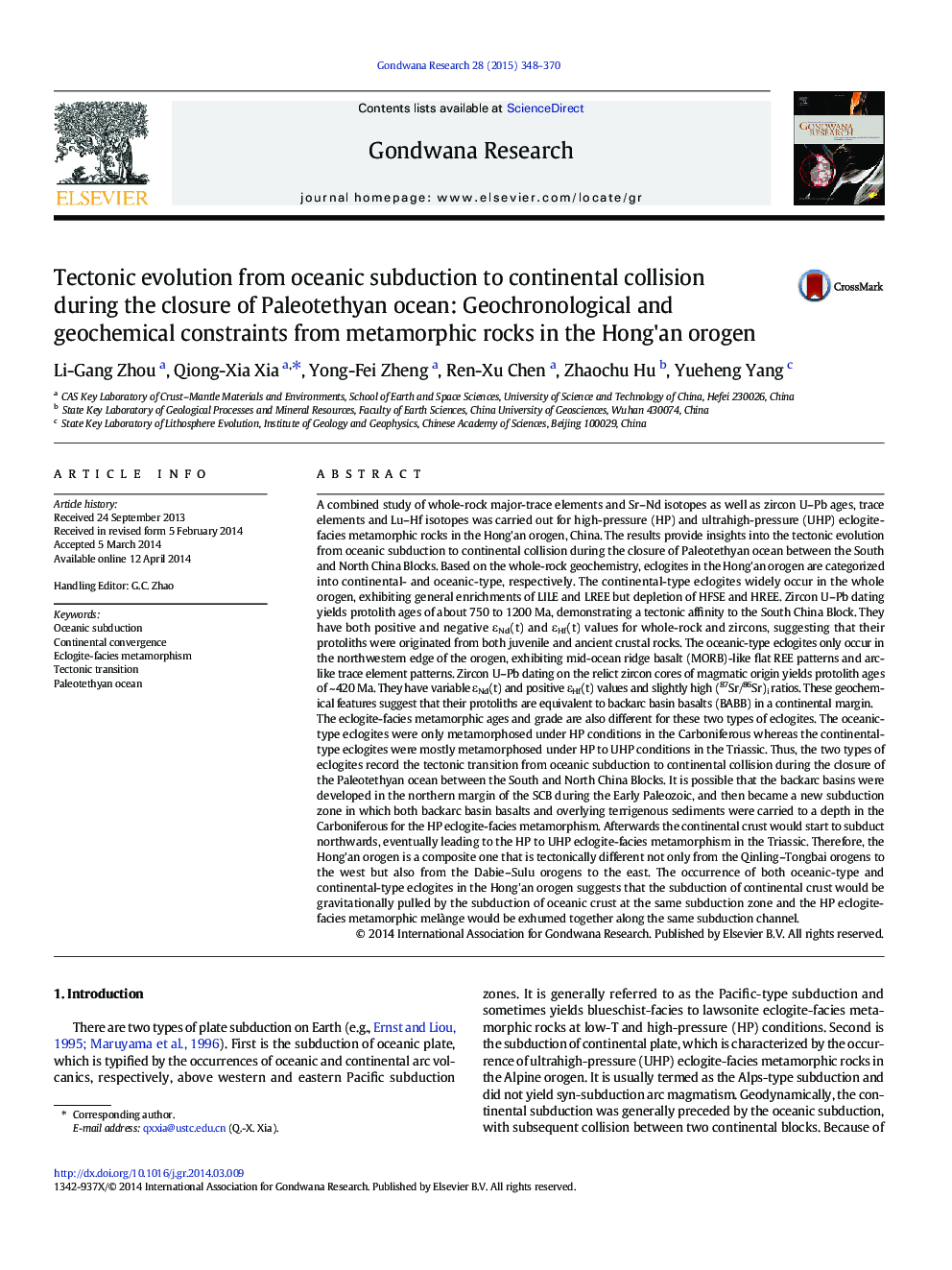| کد مقاله | کد نشریه | سال انتشار | مقاله انگلیسی | نسخه تمام متن |
|---|---|---|---|---|
| 4726813 | 1356347 | 2015 | 23 صفحه PDF | دانلود رایگان |
• Both oceanic- and continental-type eclogites occur in the Hong’an orogen.
• The orogen records the transition from oceanic subduction to continental collision.
• Only the oceanic-type eclogites underwent the Carboniferous HP metamorphism.
• The whole Hong’an orogen experienced the Triassic eclogite-facies metamorphism.
• Back-arc basin basalts are suggested as the protoliths of oceanic-type eclogites.
A combined study of whole-rock major-trace elements and Sr–Nd isotopes as well as zircon U–Pb ages, trace elements and Lu–Hf isotopes was carried out for high-pressure (HP) and ultrahigh-pressure (UHP) eclogite-facies metamorphic rocks in the Hong'an orogen, China. The results provide insights into the tectonic evolution from oceanic subduction to continental collision during the closure of Paleotethyan ocean between the South and North China Blocks. Based on the whole-rock geochemistry, eclogites in the Hong'an orogen are categorized into continental- and oceanic-type, respectively. The continental-type eclogites widely occur in the whole orogen, exhibiting general enrichments of LILE and LREE but depletion of HFSE and HREE. Zircon U–Pb dating yields protolith ages of about 750 to 1200 Ma, demonstrating a tectonic affinity to the South China Block. They have both positive and negative εNd(t) and εHf(t) values for whole-rock and zircons, suggesting that their protoliths were originated from both juvenile and ancient crustal rocks. The oceanic-type eclogites only occur in the northwestern edge of the orogen, exhibiting mid-ocean ridge basalt (MORB)-like flat REE patterns and arc-like trace element patterns. Zircon U–Pb dating on the relict zircon cores of magmatic origin yields protolith ages of ~ 420 Ma. They have variable εNd(t) and positive εHf(t) values and slightly high (87Sr/86Sr)i ratios. These geochemical features suggest that their protoliths are equivalent to backarc basin basalts (BABB) in a continental margin.The eclogite-facies metamorphic ages and grade are also different for these two types of eclogites. The oceanic-type eclogites were only metamorphosed under HP conditions in the Carboniferous whereas the continental-type eclogites were mostly metamorphosed under HP to UHP conditions in the Triassic. Thus, the two types of eclogites record the tectonic transition from oceanic subduction to continental collision during the closure of the Paleotethyan ocean between the South and North China Blocks. It is possible that the backarc basins were developed in the northern margin of the SCB during the Early Paleozoic, and then became a new subduction zone in which both backarc basin basalts and overlying terrigenous sediments were carried to a depth in the Carboniferous for the HP eclogite-facies metamorphism. Afterwards the continental crust would start to subduct northwards, eventually leading to the HP to UHP eclogite-facies metamorphism in the Triassic. Therefore, the Hong'an orogen is a composite one that is tectonically different not only from the Qinling–Tongbai orogens to the west but also from the Dabie–Sulu orogens to the east. The occurrence of both oceanic-type and continental-type eclogites in the Hong'an orogen suggests that the subduction of continental crust would be gravitationally pulled by the subduction of oceanic crust at the same subduction zone and the HP eclogite-facies metamorphic melànge would be exhumed together along the same subduction channel.
Figure optionsDownload as PowerPoint slide
Journal: Gondwana Research - Volume 28, Issue 1, August 2015, Pages 348–370
